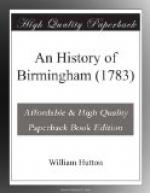In Mitchly-park, three miles west of Birmingham, in the parish of Edgbaston, is The Camp; which might be ascribed to the Romans, lying within two or three stones cast of their Ikenield-street, where it divides the counties of Warwick and Worcester, but is too extensive for that people, being about thirty acres: I know none of their camps more than four, some much less; it must, therefore, have been the work of those pilfering vermin the Danes, better acquainted with other peoples property than their own; who first swarmed on the shores, then over-ran the interior parts of the kingdom, and, in two hundred years, devoured the whole.
No part of this fortification is wholly obliterated, though, in many places, it is nearly levelled by modern cultivation, that dreadful enemy to the antiquary. Pieces of armour are frequently ploughed up, particularly parts of the sword and the battle-axe, instruments much used by those destructive sons of the raven.
The platform is quadrangular, every side nearly four hundred yards; the center is about six acres, surrounded by three ditches, each about eight yards over, at unequal distances; though upon a descent, it is amply furnished with water. An undertaking of such immense labour, could not have been designed for temporary use.
The propriety of the spot, and the rage of the day for fortification, seem to have induced the Middlemores, lords of the place for many centuries, and celebrated for riches, but in the beginning of this work, for poverty, to erect a park, and a lodge; nothing of either exist, but the names.
MORTIMER’s BANK.
The traveller who undertakes an extensive journey, cannot chuse his road, or his weather: sometimes the prospect brightens, with a serene sky, a smooth path, and a smiling sun; all within and without him is chearful.
Anon he is assailed by the tempests, stumbles over the ridges, is bemired in the hollows, the sun hides his face, and his own is sorrowful—this is the lot of the historian; he has no choice of subject, merry or mournful, he must submit to the changes which offer; delighted with the prosperous tale, depressed with the gloomy.
I am told, this work has often drawn a smile from the reader; it has often drawn a sigh from me. A celebrated painter fell in love with the picture he drew; I have wept at mine—Such is the chapter of the Lords, and the Workhouse. We are not always proof against a melancholy or a tender sentiment.
Having pursued our several stages, with various fortune, through fifty chapters, at the close of this last tragic scene, emotion and the journey cease together.
Upon King’s-wood, five miles from Birmingham, and two hundred yards east of the Alcester-road, runs a bank for near a mile in length, unless obliterated by the new inclosure; for I saw it complete in 1775. This was raised by the famous Roger Mortimer, Earl of March, about 1324, to inclose a wood, from whence the place derives its name.




